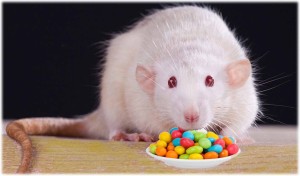 Toxicology and Industrial Health, 2013. March; 29(2): 224-32. doi: 10.1177/0748233711433935
Toxicology and Industrial Health, 2013. March; 29(2): 224-32. doi: 10.1177/0748233711433935
The researchers wanted to evaluate the toxic effect of some synthetic colorants and/or flavors on body organs and metabolism in rats. They used 10 groups of 10 male albino rats each. All rats were fed the same basic diet, with the additions as follows, for 42 days:
- Group 1 was the control, fed just ordinary rat chow.
- Group 2 was given Brilliant Blue (Blue 1), 123 mg/kg
- Group 3 was given Carmoisine (a red dye not used in the US), 70 mg/kg
- Group 4 was given Tartrazine (Yellow 5), 75mg/kg
- Group 5 was given Trans-Anethole (flavor), 4.5 g/kg
- Group 6 was given Propylene Glycol (flavor), 0.25 g/kg
- Group 7 was given Vanillin (flavor), 1.25 g/kg
- Group 8 was given Brilliant Blue + Propylene Glycol
- Group 9 was given Carmoisine + Trans-Anethole
- Group 10 was given Tartrazine + Vanillin
Compared to the control group, the following changes were significant in all test groups:
- Decreased body weight.
- Decreased hemoglobin.
- Decreased red blood cell count.
- Decreased activity of reduced glutathione, glutathione-S-transferase and superoxide dismutase in both blood and liver.
- Increased serum alanine aminotransferase.
- Increased aspartate aminotransferase.
- Increased alkaline phosphatase.
- Increased bilirubin.
- Increased urea.
- Increased creatinine.
- Increased total protein.
- Increased albumin.
The authors said that the increased ALT and AST liver enzymes indicated liver damage, as these enzymes are liberated when liver cells are destroyed.
Separately, the authors discussed the decreased growth rate of all the rats exposed to colorants, even though all the rats in the treated groups ate more than the control group rats. They suggested that the food dyes may bind to the bacterial cell surface in the rat’s intestine, preventing absorption of nutrients.
QUOTE: “it is advisable to limit the uses of these food colorants and/or food flavor additives especially those used by children.”
MedLine || Full Text || Get Password




















